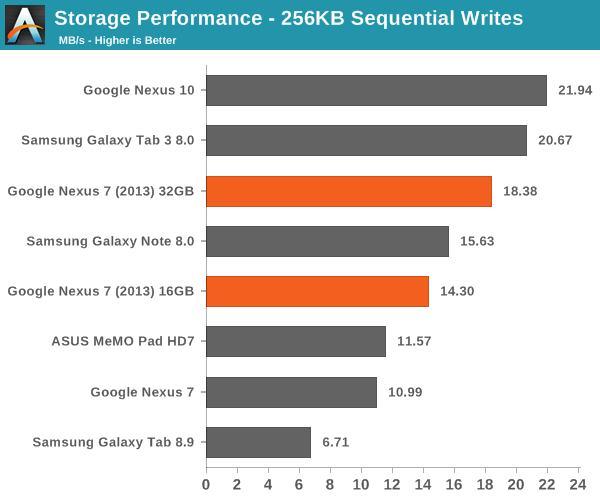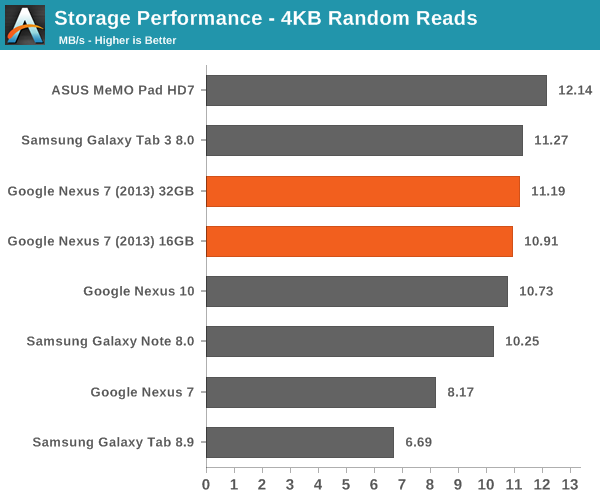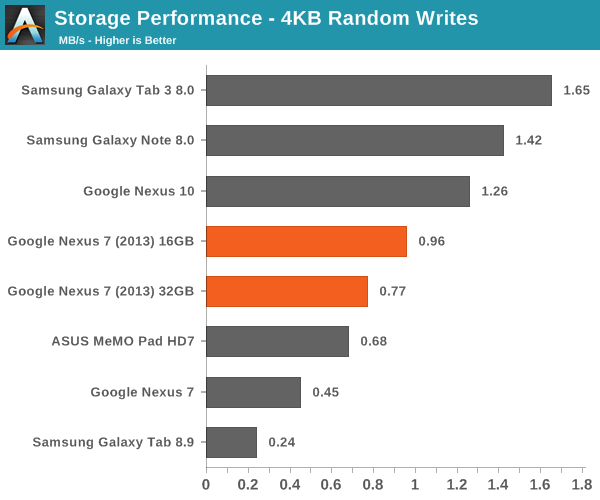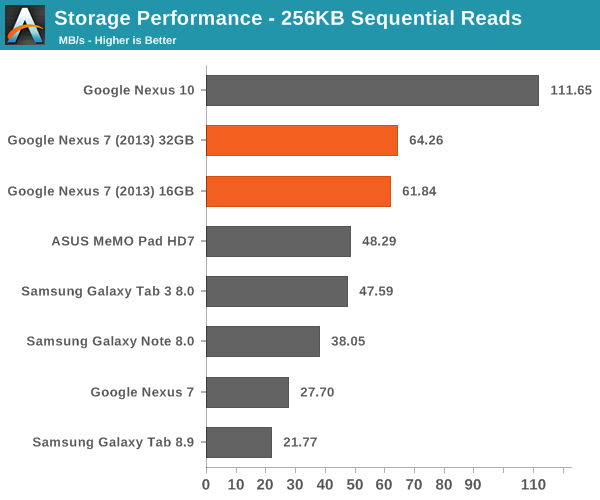The Nexus 7 (2013) Review
by Anand Lal Shimpi on August 22, 2013 6:00 PM ESTeMMC and FSTRIM
The new Nexus 7 obviously ships with the latest version of Android (4.3), which happens to add a major feature for keeping storage performance high: fstrim. Modern smartphones and tablets fundamentally use a very similar storage architecture to what we see in modern SSDs (solid state drives) in PCs. Instead of a drive featuring a discrete controller, DRAM and NAND flash, these ultra mobile devices typically feature one or two NAND devices with an integrated controller - typically eMMC. To keep costs (and power consumption) low there's also no DRAM cache, which definitely harms performance.
Since the underlying architectures are quite similar, the pitfalls are the same as well. The biggest issue? Performance when operating in a full or near-full state. With tons of files on your internal storage, the data structures that have to track all of those files and where they're located in NAND space get pretty complex, and traversing those structures takes a considerable amount of time. The part that many seem to forget is that once you delete a file in Android, it's not immediately removed from internal storage. The space is freed up in the OS, but the eMMC controller still tracks all of the data as valid bits. It's only when that data is overwritten that the controller knows the previous data didn't matter.
In other words, it's possible to have tons of free space on your internal storage, but have the drive appear full to the eMMC controller (and thus enjoy all of the terrible performance that goes along with it). To make matters worse, you never even have to fill your drive to get it into this state. In order to maintain even wear across all NAND cells (to extend the lifespan of the NAND flash), the eMMC controller will write to new/empty blocks in NAND as much as possible. Let's say you have 10GB of storage and Android writes 1GB of data to new addresses every month and deletes the previous 1GB each time. As long as the addresses being written to never overlap, your drive will be full in 10 months (from the eMMC controller's perspective) but Android will still report 9GB of free space.
fstrim establishes communication between the OS and the eMMC controller to address this problem - and it's enabled in Android 4.3.
Unlike TRIM on standard SSDs, FS_TRIM works more like the manual/scheduled TRIM tools from the early days of consumer SSDs. From Brian's original Android 4.3/TRIM article:
The Android framework will send out a “start idle maintenance window” event that the MountService listens for, and then invokes vold to fstrim filesystems when a few conditions have been met – the device hasn’t been touched for over an hour, no idle maintenance window event has been sent in 24 hours, and the device is either off-charger with 80% battery or on-charger with 30% battery. The goal is to have fstrim run roughly once every 24 hours if you’re in the habit of plugging the device in to charge every night.
Personally I feel like the rules are a bit excessive and I'd love to see us get to active TRIM on these devices, but I guess it's a bit too early for that. Basically if your device has enough charge and you're not using it, Android 4.3 will issue an fstrim command to the eMMC controller. The command passes along a list of all unallocated addresses in the filesystem, which the eMMC controller can then use to purge its logical to physical mapping table/list/datastructure. The process should complete relatively quickly as no new data has to be written, the controller just needs to do some cleanup of internal structures and add a bunch of addresses to the unused block pool. Keep in mind that this simply addresses the issue of your storage getting slower over time. fstrim does nothing to keep performance high if you actually fill your storage to capacity. Given how bad these eMMC solutions are, my recommendation is to try and keep at least 20% of your internal storage unused/as free space.
To showcase just how bad things can get I actually dusted off last year's Nexus 7 and treated it like an SSD. I first filled the device with sequential data, leaving only 300MB free. I then performed back to back random writes across the remaining free space and the performance reduction:
| Nexus 7 (2012) Storage Performance | ||||||
| Sequential Read | Sequential Write | Random Read | Random Write | |||
| New After Factory Reset | 25.18 MB/s | 10.63 MB/s | 7.08 MB/s | 0.45 MB/s | ||
| 1st Run After Fill | 22.25 MB/s | 1.21 MB/s | 7.62 MB/s | 0.14 MB/s | ||
| 2nd Run After Fill | 26.00 MB/s | 1.97 MB/s | 7.8 MB/s | 0.11 MB/s | ||
| 3rd Run After Fill | 24.57 MB/s | 3.18 MB/s | 7.96 MB/s | 0.16 MB/s | ||
| After ~24 hours Idle Time | 27.03 MB/s | 11.21 MB/s | 7.65 MB/s | 0.46 MB/s | ||
The columns to pay the most attention to are the write columns (read performance shouldn't change over time). Note that sequential write speed drops by almost an order of magnitude. This incredible drop in performance manifests itself as pauses or stutters. Even when you're just performing simple tasks on your tablet, there are usually tons of background operations going on (e.g. updating system logs). If you look at random write performance here, we see performance drop down to 0.11MB/s - or roughly 27 IO operations per second. If you have more than that amount of IO coming in at the same time, what you'll get are long pauses while the eMMC controller works through its IO queue. Although I didn't include it in the table above, I spent a full day torturing the eMMC on this Nexus 7 and managed to get random write performance as low as 0.02MB/s or 5 IOPS. Sequential write performance in that case was 0.81MB/s, equally disheartening. My point here is that worst case storage performance can get very bad, but looking at the last line of the table you see the incredible impact fstrim has on restoring performance.
I/fstrim ( 118): Starting fstrim work...
I/fstrim ( 118): Invoking FITRIM ioctl on /cache
I/fstrim ( 118): Trimmed 445079552 bytes on /cache
I/fstrim ( 118): Invoking FITRIM ioctl on /data
I/fstrim ( 118): Trimmed 13637656576 bytes on /data
I/fstrim ( 118): Finished fstrim work.
Anyone who had issues with their Nexus 7 slowing down over time will want to upgrade to Android 4.3. Those users considering upgrading to the new Nexus 7 should be fine thanks to fstrim. The only situation where you should see tremendous decrease in storage performance, resulting in IO latency enduced pausing/stuttering is if you physically fill the internal storage close to capacity. Again - my recommendation here is to try and leave at least 20% of your internal storage free. Note that this recommendation applies across Android and iOS.
With all of that out of the way, how does the eMMC solution in the new Nexus 7 stack up? Sequential read performance continues to be quite good for such a small/lower power device. Sequential write speed isn't terrible either. Even random read performance looks solid. It's random write performance that just needs work across the industry. We realistically need to probably be at 10x where we are today in random write performance, perhaps a bit lower if the storage makers can focus on IO consistency/minimum sustained IOPS.
Storage solutions in these tablets are often sourced from multiple vendors, and we can see dramatic differences in performance between them. Brian's review sample was a 32GB model, while the tablet I reviewed had 16GB. The two solutions performed pretty similarly, although my 16GB model did have appreciably better random write performance. Ultimately if you need the space, the 32GB model will be the better performer (you're better off using 45% of a 32GB model than 90% of a 16GB model).














202 Comments
View All Comments
iampivot - Saturday, August 24, 2013 - link
Is the GSM modem on the 4G / LTE version locked down, so that you cannot make calls nor send SMS messages, like the original nexus 7?Shukla - Saturday, August 24, 2013 - link
Is it me or is this about 1 year behind iPad? So google puts out an iPad 4 competitor 1 year later??I'm no apple junkie but why is it that each year apple resets the bar and everyone spends the year catching up but not passing in everyway?
1. No individual app privacy controls
2. Longer battery life than iPad/iPhone (by wide margin).
I need a job with google marketing- they suck.
GTBandit22 - Saturday, August 24, 2013 - link
Well considering this is a 7 inch tablet, and half the cost of the entry level iPad, I would say you're making a bad comparison.I would say that Apple is behind in the small form factor race. 6 months behind.
akdj - Sunday, August 25, 2013 - link
Possibly because the released (Apple) their tablet nine months ago? It'll never end. They're working six months apart. With each company's current release, it'll 'best' the six month old competitors. Technology, especially low power SOC and GPU designs are developing at a rapid pace. Give it a couple months and we'll see the same thing happen with Apple's new lineup. In fact, the iPad 4 is still holding up...as is the iPhone 5 to the current crop of Android releases (other than extreme screen sizes). I like what Google is now doing with their Nexus series. Like Apple, they're designing (or helping design) the hardware and optimizing their software to work efficiently together. Super smart decision without the carrier and OEM skins we've had to live with until these new Nexus tablets have released. Smart. Idea.lightsout565 - Sunday, August 25, 2013 - link
Can someone provide me a link with a more detailed outline of how the WiFi web browsing test is conducted? Thanks!mikeyfouc - Monday, August 26, 2013 - link
Can this plug into a VGA overhead projector to mirror the screen? I'd really like to get a tablet that allows me to show Powerpoint presentations on a VGA projector. I've seen AT's review of SlimPort, but it only has a video of the mirroring on a widescreen HD TV via HDMI. Also, I've searched all over the web: can Android show powerpoint presentations in slideshow mode (as you'd see on a PC)?Shopov - Tuesday, August 27, 2013 - link
Excelent review! My question-Nexus 7 (2012) does not support WiFi Ad Hoc (ibss). This is boring since its only WiFi version (no LTE) cannot receive WiFi from tethered smartphone (mine is Nokia C-7). What about the WiFi of the new Nexus 2013? If the answer is positive this would be a big advantage. I should mention that several Android 4 tablets receive WiFi Ad Hoc (ibss).Nexus 7 2013 - Thursday, August 29, 2013 - link
For anyone considering this device, please check out the forum on Google :https://productforums.google.com/forum/#!topic/mob...
Majority are as reviewed, but a small, yet growing number are effected by software/hardware issues that, after a month's time, are yet to be concretely dealt with.
Buy only from a vendor having a good solid return/exchange /refund policy.
Hrel - Thursday, August 29, 2013 - link
No 802.11ac?! Lame."The beauty of not having to double the original Nexus 7's resolution but instead settling on an in-between option like 1920 x 1200 is that Google could get away with a performance mainstream SoC instead of something ridiculously high-end."' ... what? That's a ridiculously high resolution, Apple is stupid for thinking a resolution that high is useful.
I'd like to see them go 16:9, make the device 8" and give it a 1920x1080 display resolution. Perhaps next year, with 802.11ac.
With that said, I can't see myself even entertaining the idea of actually buying a tablet unless it's gaming focused like the Nvidia... thingy...I forget the name.
This is how I see it, tablets are secondary for web browsing in the first place, anyone in their right mind prefers using a laptop. Which, let's face it, anyone who can afford a tablet already has. So, WHY would someone buy a device where the primary focus is web browsing? Give me a tablet that's focused on mobile gaming (PSP/gameboy style) that also has all the functionality of one of these tablets, web browsing. I think Nvidia is on the right track, streaming desktop games so you can lie in bed and play without having a laptop on your chest and your wrists angled awkwardly. Play mobile games when away from home/on a plane/cab. Also allows you to read ebooks and listen to audio books AND check facebook/reddit/anandtech/twitter whatever, newegg and amazon and such.
I think if Nvidia just keeps doing what they're doing they're next gen "tablet" could be the perfect device. The only recommendation I'd make is to choose to focus on making it as good a mobile reader as an IPS display can be, it won't ever be as good as a kindle with that Eink display, but if it's close enough, and they can produce numbers to show no meaningful eye strain then I'm sold. They've gotta compete with Razer Edge, or whatever, too.
justacousin - Tuesday, September 3, 2013 - link
So what is going to be Nexus devices in improving their device?